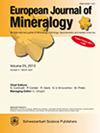Manganrockbridgeite, Mn2+2Fe3+3(PO4)3(OH)4(H2O), a new member of the rockbridgeite group, from the Hagendorf-Süd pegmatite, Oberpfalz, Bavaria
IF 1.7
3区 地球科学
Q2 MINERALOGY
引用次数: 0
Abstract
Abstract. Manganrockbridgeite, Mn22+Fe33+(PO4)3(OH)4(H2O), is a new member of the rockbridgeite group, from the Hagendorf-Süd pegmatite, Oberpfalz, Bavaria. It occurs in association with frondelite, kenngottite, hureaulite and hematite. It forms compact intergrowths and clusters of shiny greenish black blades up to 200 µm long and 20 µm wide but only a few micrometres thick. The crystals are elongated on [100] and flattened on {001}, with perfect cleavage parallel to {001}. Individual thin blades are green in transmitted light and red under crossed polars. The calculated density is 3.40 g cm−3. Manganrockbridgeite is biaxial (+/-), with α= 1.795(5), β= 1.805(calc), γ=1.815(5) (white light) and 2V(meas.) = 90(2)∘. The empirical formula from electron microprobe analyses, Mössbauer spectroscopy and crystal structure refinement is (Mn1.072+Fe0.692+Fe0.163+)Σ1.92(Fe3+)2.88(PO4)3(OH)3.64(H2O)1.44. Manganrockbridgeite has monoclinic symmetry with space group P21/m and unit-cell parameters a=5.198(2), b=16.944(5), c=7.451(3) Å, β=110.170(9)∘, V=616.0(4) Å3 and Z=2. The crystal structure was refined using both laboratory and synchrotron single-crystal diffraction data. Whereas other rockbridgeite-group minerals have orthorhombic symmetry with a statistical distribution of 50 % Fe3+ / 50 % vacancies in M3-site octahedra forming face-shared chains along the 5.2 Å axis, monoclinic manganrockbridgeite has full ordering of Fe3+ and vacancies in alternate M3 sites along the 5.2 Å axis.锰岩桥岩,Mn2+2Fe3+3(PO4)3(OH)4(H2O),是岩桥岩组的新成员,来自巴伐利亚Oberpfalz的hagendorf - s伟晶岩
摘要Manganrockbridgeite,Mn22+Fe33+(PO4)3(OH)4(H2O),是来自巴伐利亚州奥伯普法尔茨Hagendorf-Süd伟晶岩的岩桥岩群的一个新成员。它与叶闪长岩、肯特红柱石、胡罗英长岩和赤铁矿共生。它形成了紧凑的共生体和高达200片的亮绿色黑色叶片簇 µm长,20 µm宽,但只有几微米厚。晶体在[100]上被拉长,在{001}上被压扁,具有平行于{001}的完美解理。单独的薄叶片在内部为绿色,在交叉极下为红色。计算出的密度为3.40 g cm−3.锰质岩为双轴(+/-),α= 1.795(5),β= 1.805(计算值),γ=1.815(5)(白光)和2V(测量值) = 90(2)∘。电子探针分析、穆斯堡尔谱和晶体结构细化的经验公式为(Mn1.072+Fe0.692+Fe0.163+)∑1.92(Fe3+)2.88(PO4)3(OH)3.64(H2O)1.44。锰桥镁石具有单斜对称性,空间群为P21/M,晶胞参数a=5.198(2),b=19.444(5),c=7.451(3) Å,β=110.170(9)∘,V=616.0(4) Å3和Z=2。使用实验室和同步单晶衍射数据对晶体结构进行了细化。而其他岩桥基岩组矿物具有正交对称性,统计分布为50 % Fe3+ / 50 % M3位点八面体中的空位沿着5.2形成面共享链 在Å轴上,单斜锰桥镁石具有Fe3+的完全有序性,并在5.2 Å轴。
本文章由计算机程序翻译,如有差异,请以英文原文为准。
求助全文
约1分钟内获得全文
求助全文
来源期刊
CiteScore
2.80
自引率
9.50%
发文量
40
审稿时长
6-12 weeks
期刊介绍:
EJM was founded to reach a large audience on an international scale and also for achieving closer cooperation of European countries in the publication of scientific results. The founding societies have set themselves the task of publishing a journal of the highest standard open to all scientists performing mineralogical research in the widest sense of the term, all over the world. Contributions will therefore be published primarily in English.
EJM publishes original papers, review articles and letters dealing with the mineralogical sciences s.l., primarily mineralogy, petrology, geochemistry, crystallography and ore deposits, but also biomineralogy, environmental, applied and technical mineralogy. Nevertheless, papers in any related field, including cultural heritage, will be considered.

 求助内容:
求助内容: 应助结果提醒方式:
应助结果提醒方式:


